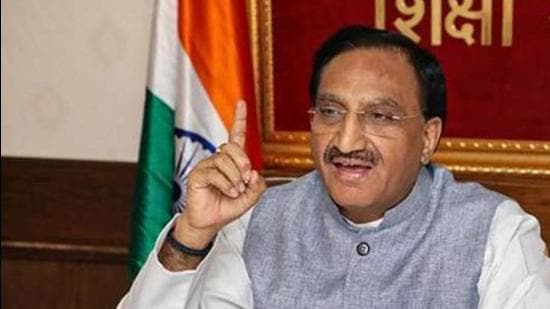Nishank resigned as education minister just ahead of NEP completing a year
Popularly known as Nishank, a pseudonym he used as a poet, he took charge of the crucial education ministry in the second term of the Modi government in 2019
Ramesh Pokhriyal stepping down as education minister on Wednesday came just ahead of the Modi government completing a year of its biggest education reform, the National Education Policy (NEP), this month. The 61-year-old former chief minister of Uttarakhand officially cited ill-health for his resignation, as he had spent over a month at the All India Institute of Medical sciences(AIIMS) recovering from coronavirus disease.

“He has not been well at all,” said a staff member in his office.
Popularly known as Nishank, a pseudonym he used as a poet, he took charge of the crucial education ministry in the second term of the Modi government in 2019. Right from the start, the choice was considered unusual because Nishank was known more for his belief in astrology and in championing the use of Sanskrit in the development of computers. However, HT has learnt that the immediate reason for his exit is that the minister was seen as too slow to take decisions which would help the government implement the NEP. Even the Sangh, which refused to comment, had one of its affiliates talk about the need to speed up its implementation.
Also Read | Dharmendra Pradhan is the new Education Minister
“The education policy was good, and the work done by them---but the implementation needs to be done at a great pace. NEP talks about great many changes needed at Central and government levels, work is needed on that. It will be a year since the policy was introduced; there needs to be a review,” said Atul Kothari of Shiksha Sanskriti Utthan Nyas, an RSS affiliate body.
NEP, which was introduced last year by the Modi government, may have been under Nishank’s watch, but was mostly devised by domain experts and a team of bureaucrats. It has been hailed by educationists and even opposition leaders with concepts like pre-school education and using mother tongue as a mode of instruction for students up to Class 5.
“It’s a great document. However, it also requires a lot of work because how are you going to get the human resource to teach pre-school children? You can’t get anganwadi workers to do this,” said a former education secretary who requested anonymity. “Also in the last few years, the allocation for education has also been going down.”
Another education official said that Nishank was also perceived as someone who was not quick to take decisions. For instance, one major problem that is yet to be sorted by the government is a common entrance exam for Delhi University. Central Universities Common Entrance Test (CUCET) is used by 15 central universities and the government is keen that Delhi university adopt it too, but that clearance is yet to come. This isn’t the only one and according to one official, there is a long list of pending decisions at the minister’s office. Other than that, there are a whole host of universities across the country that are operating without a Vice-Chancellor.
“Basically, the government has gone for an image makeover. Nishank invited controversy,” said a senior bureaucrat.
Soon after he became education minister in 2019, Nishank went to the IIT Bombay convocation and claimed that NASA had acknowledged Sanskrit’s potential as a scientific language. It turned out to be a hoax that was viral on the internet.
The new education minister Dharmendra Pradhan is expected to be at the IIT directors’ meeting as one of his first appointments of his new assignment on Thursday.





